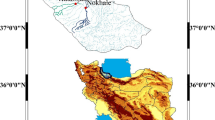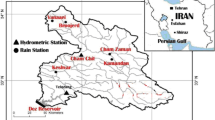Abstract
Quantification and prediction of drought events are important for planning and management of water resources in coping with climate change scenarios at global and local scales. In this study, heuristic approaches including Co-Active Neuro Fuzzy Inference System (CANFIS), Multi-Layer Perceptron Neural Network (MLPNN) and Multiple Linear Regression (MLR) were utilized to predict the hydrological drought based on multi-scalar Streamflow Drought Index (SDI) at Naula and Kedar stations located in upper Ramganga River basin, Uttarakhand State, India. The SDI was calculated on 1-, 3-, 6-, 9-, 12- and 24-month time scales (SDI-1, SDI-3, SDI-6, SDI-9, SDI-12, and SDI-24) using monthly streamflow data of 33 years (1975-2007). The significant input variables (lags) for CANFIS, MLPNN, and MLR models were derived using autocorrelation and partial autocorrelation functions (ACF &PACF) at 5% significance level on SDI-1, SDI-3, SDI-6, SDI-9, SDI-12 and SDI-24 data series. The predicted values of multi-scalar SDI using CANFIS, MLPNN and MLR models were compared with the calculated values, based on root mean squared error (RMSE), Nash-Sutcliffe efficiency (NSE), coefficient of correlation (COC) and Willmott index (WI). The visual interpretation was also made using line diagram, scatter diagram and Taylor diagram (TD). The results of analysis revealed that the performance of CANFIS models was the best for hydrological drought prediction at 3-, 6- and 12-month time scales for Naula station, and at 1-, 3-, 12- and 24-month time scales for Kedar station; while MLPNN was the best at 1- and 9-month time scales for Naula station, and at 6- and 9-month time scales for Kedar station. The MLR model was found to be the best at 24-month time scale for Naula station only. The results of this study could be helpful in prediction of hydrological drought on multiple time scales and decision making for remedial schemes to cope with hydrological drought at Naula and Kedar stations.











Similar content being viewed by others
References
Ali M, Deo RC, Downs NJ, Maraseni T (2018) An ensemble-ANFIS based uncertainty assessment model for forecasting multi-scalar standardized precipitation index. Atmos Res 207:155–180
Aytek A (2009) Co-active neuro-fuzzy inference system for evapotranspiration modelling. Software and Computers 13:691–700
Bacanli UG, Firat M, Dikbas F (2009) Adaptive neuro-fuzzy inference system for drought forecasting. Stoch Env Res Risk A 23(8):1143–1154
Belayneh A, Adamowski J (2012) Standard precipitation index drought forecasting using neural networks, wavelet neural networks, and support vector regression. Appl Comput Intell Soft Comput. https://doi.org/10.1155/2012/794061
Belayneh A, Adamowski J, Khalil B, Ozga-Zielinski B (2014) Long-term SPI drought forecasting in the Awash River basin in Ethiopia using wavelet neural network and wavelet support vector regression models. J Hydrol 508:418–429
Borji M, Malekian A, Salajegheh A, Ghadimi M (2018) Multi-time-scale analysis of hydrological drought forecasting using support vector regression (SVR) and artificial neural networks (ANN). Arab J Geosci 9:1–10
Dawson CW, Wilby RL (2001) Hydrological modelling using artificial neural networks. Prog Phys Geogr 25(1):80–108
Deo RC, Sahin M (2015a) Application of the extreme learning machine algorithm for the prediction of monthly effective drought index in eastern Australia. Atmos Res 153:512–525
Deo RC, Sahin M (2015b) Application of the artificial neural network model for prediction of monthly standardized precipitation and evapotranspiration index using hydrometeorological parameters and climate indices in eastern Australia. Atmos Res 161:65–81
Deo RC, Tiwari MK, Adamowski JF, Quilty JM (2016) Forecasting effective drought index using a wavelet extreme learning machine (W-ELM) model. Stoch Env Res Risk A 31(5):1211–1240
Deo RC, Kisi O, Singh VP (2017) Drought forecasting in eastern Australia using multivariate adaptive regression spline, least square support vector machine and M5 tree model. Atm Res 184:149–175
Haykin S (1998) Neural networks-a comprehensive foundation (2nd eds.) London. Prentice-Hall, Upper Saddle River, pp 26–32
Jang JR, Sun CT, Mizutani E (1997) Neuro fuzzy and soft computing: a computational approach to learning and machine intelligence. Prentice-Hall, NJ, USA, p 607
Landeras G, Ortiz-Barredo A, López JJ (2009) Forecasting weekly evapotranspiration with ARIMA and artificial neural network models. J Irrig Drain Eng 135(3):323–334
Malik A, Kumar A (2015) Pan evaporation simulation based on daily meteorological data using soft computing techniques and multiple linear regression. Water Resour Manag 29(6):1859–1872
Malik A, Kumar A, Kisi O (2017) Monthly pan-evaporation estimation in Indian Central Himalayas using different heuristic approaches and climate based models. Comput Electron Agric 143:302–313
Malik A, Kumar A, Kisi O (2018) Daily pan evaporation estimation using heuristic methods with gamma test. J Irrig Drain Eng. https://doi.org/10.1061/(ASCE)IR.1943-4774.0001336
McCulloch WS, Pitts W (1943) A logical calculus of the ideas imminent in nervous activity. Bull Math Biophys 5:115–133
McKee TB, Doesken NJ, Kleist J (1993) The relationship of drought frequency and duration to time scales. In: Proceedings of the 8th conference on Appl. Climatol. Anaheim, CA, USA, p 179–184
Mehr AD, Kahya E, Özger M (2014) A gene–wavelet model for long lead time drought forecasting. J Hydrol 517:691–699
Mishra AK, Desai VR (2006) Drought forecasting using feed-forward recursive neural network. Ecol Model 198:127–138
Mishra AK, Singh VP (2009) Analysis of drought severity-area-frequency curves using a general circulation model and scenario uncertainty. J Geophys Res 114:1–18
Mishra AK, Singh VP (2010) A review of drought concepts. J Hydrol 391:202–216
Mishra AK, Singh VP (2011) Drought modelling-a review. J Hydrol 403:157–175
Mokhtarzad M, Arabasadi A, Eskandari F, Vanjani NJ, Arabasadi A (2017) Drought forecasting by ANN, ANFIS, and SVM and comparison of the model. Environ Earth Sci 76:1–10
Morid S, Smakhtin V, Bagherzadeh K (2007) Drought forecasting using artificial neural networks and time series of drought indices. Int J Climatol 27:2103–2111
Mouatadid S, Raj N, Deo RC, Adamowski JF (2018) Input selection and data-driven model performance optimization to predicting standardized precipitation and evaporation index in a drought-prone region. Atmos Res 212:130–149
Myronidis D, Ioannou K, Fotakis D, Dörflinger G (2018) Streamflow and hydrological drought trend analysis and forecasting in Cyprus. Water Resour Manag 32:1759–1776
Nalbantis I (2008) Evaluation of a hydrological drought index. Eur Water 23(24):67–77
Nalbantis I, Tsakiris G (2009) Assessment of hydrological drought revisited. Water Resour Manag 23:881–897
Nash JE, Sutcliffe JV (1970) River flow forecasting through conceptual models: part 1. A discussion of principles. J Hydrol 10(3):282–290
Nguyen LB, Li QF, Ngoc TA, Hiramatsu K (2015) Adaptive neuro-fuzzy inference system for drought forecasting in the Cai river basin in Vietnam. J Fac Agric Kyushu Univ 60(2):405–415
Nguyen VH, Li QF, Nguyen LB (2017) Drought forecasting using ANFIS-a case study in drought prone area of Vietnam. Paddy Water Environ. https://doi.org/10.1007/s10333-017-0579-x
Ozger M, Mishra AK, Singh VP (2012) Long lead time drought forecasting using a wavelet and fuzzy logic combination model: a case study in Texas. J Hydrometeorol 13:284–229
Rafiei-Sardooi E, Mohseni-Saravi M, Barkhori S, Azareh A, Choubin B, Jafari-Shalamzar M (2018) Drought modeling: a comparative study between time series and neuro-fuzzy approaches. Arab J Geosci 11:1–9
Rezaeian-Zadeh M, Tabari H (2012) MLP-based drought forecasting in different climatic regions. Theor Appl Climatol 109(3-4):407–414
Shirmohammadi B, Moradi H, Moosavi V, Semiromi MT, Zeinali A (2013) Forecasting of meteorological drought using wavelet ANFIS hybrid model for different time steps (case study: south-eastern part of East Azerbaijan province, Iran). Nat Hazards. https://doi.org/10.1007/s11069-013-0716-9
Soh YW, Koo CH, Huang YF, Fung KF (2018) Application of artificial intelligence models for the prediction of standardized precipitation evapotranspiration index (SPEI) at Langat River basin, Malaysia. Comput Electron Agric 144:164–173
Sudheer KP, Gosain AK, Ramasastri KS (2002) A data-driven algorithm for constructing artificial neural network rainfall-runoff models. Hydrol Process 16:1325–1330
Tabari H, Talaee PH, Abghari H (2012) Utility of coactive fuzzy inference system for pan evaporation modelling comparison with multilayer perceptron. Meteorog Atmos Phys 116:147–154
Tabari H, Nikbakht J, Talaee PH (2013) Hydrological drought assessment in north western Iran based on streamflow drought index (SDI). Water Resour Manag 27:137–151
Taylor KE (2001) Summarizing multiple aspects of model performance in a single diagram. J Geophys Res Atmos 106(D7):7183–7192
Tiwari MK, Adamowski J (2013) Urban water demand forecasting and uncertainty assessment using ensemble wavelet-bootstrap-neural network models. Water Resour Res 49:6486–6507
Wilhite DA, Glantz MH (1985) Understanding the drought phenomenon: the role of definitions. Water Int 10:111–120
Willmott CJ (1981) On the validation of models. Phys Geogr 2(2):184–194
Author information
Authors and Affiliations
Corresponding author
Ethics declarations
Conflict of Interest
The authors declare no conflict of interest.
Additional information
Publisher’s Note
Springer Nature remains neutral with regard to jurisdictional claims in published maps and institutional affiliations.
Rights and permissions
About this article
Cite this article
Malik, A., Kumar, A. & Singh, R.P. Application of Heuristic Approaches for Prediction of Hydrological Drought Using Multi-scalar Streamflow Drought Index. Water Resour Manage 33, 3985–4006 (2019). https://doi.org/10.1007/s11269-019-02350-4
Received:
Accepted:
Published:
Issue Date:
DOI: https://doi.org/10.1007/s11269-019-02350-4




